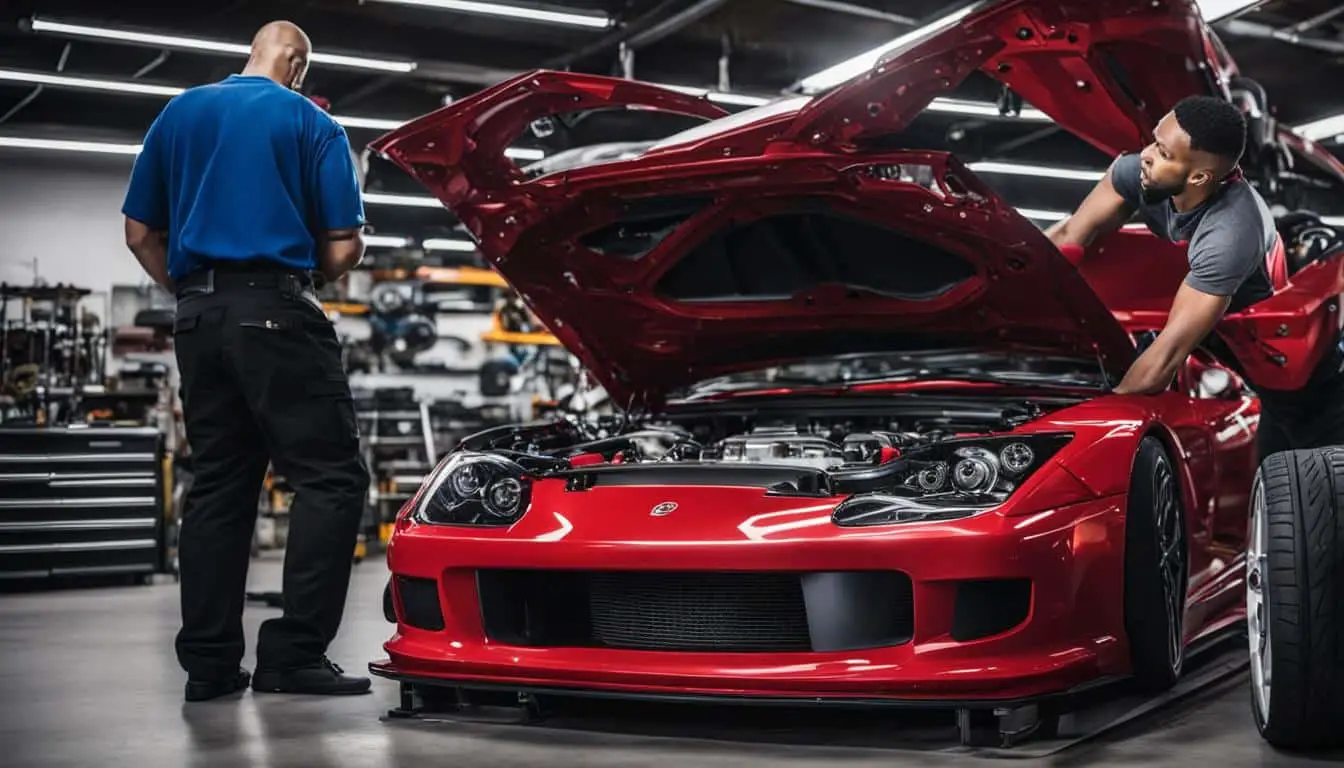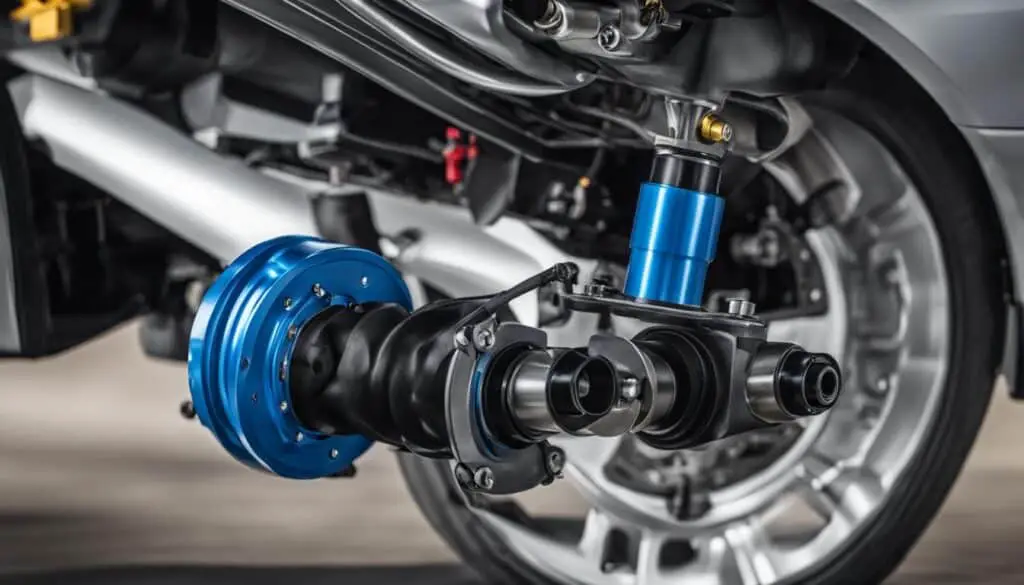
The Essentials of Car Suspension Tuning
As a professional car journalist, I have learned that optimizing your car’s suspension system is crucial to achieve the desired comfort and performance. With the right suspension tuning techniques, you can enhance your car’s handling, stability, and responsiveness, making your driving experience more enjoyable. In this section, I will share some of the essential tips and techniques for car suspension tuning and explain the benefits of car suspension upgrades.
Key Takeaways:
- Car suspension tuning is essential for enhancing comfort and performance.
- Optimizing suspension can improve handling, stability, and responsiveness.
- Car suspension upgrades can transform your driving experience.
- Proper suspension tuning requires adjusting ride height, damping, and spring rates.
- Alignment and balance are crucial for optimal performance.
Understanding Suspension Tuning Techniques
In this section, I will delve into the various techniques used in suspension tuning. A well-tuned suspension system can make all the difference in a car’s performance, handling, and comfort. Therefore, it is essential to understand the different aspects of car suspension setup.
Ride Height Adjustment
Adjusting the ride height of a car is a common technique used in suspension tuning. Lowering the car’s center of gravity can improve handling, reduce body roll, and enhance its appearance. However, it’s crucial to strike the right balance between looks and functionality. Lowering the car too much can negatively impact ride quality and cause clearance issues with speed bumps, curbs, and steep inclines.

Damping Adjustment
Damping is the resistance that shocks and struts provide to the up-and-down movement of your car’s wheels. Adjusting damping allows you to control how quickly the suspension compresses and rebounds. Stiffening the damping can improve handling, reduce body roll, and provide a more responsive feel. On the other hand, softening the damping can increase ride comfort and absorb bumps better.
Spring Rate Adjustment
The spring rate refers to how stiff or soft the springs are in your car’s suspension system. Changing the spring rate can improve handling, reduce body roll, and enable better weight transfer during hard corners and braking. Stiffening the springs can make the car more responsive and reduce body roll, while softening the springs can improve ride comfort.
Alignment and Balance
Proper alignment and balance are crucial aspects of suspension tuning. Misaligned or unbalanced wheels can cause uneven tire wear, reduced performance, and poor handling. Ensuring that the wheels are perfectly aligned and balanced can improve handling, performance, and ride quality.
Expert Tip: A comprehensive suspension tuning guide can help you understand the different techniques and how they work together to optimize your car’s suspension system.
By understanding these suspension tuning techniques, you can fine-tune your car’s suspension system to achieve your desired balance between performance and comfort. Keep in mind that suspension tuning is a highly personal process, and what works for one driver may not work for another. Therefore, it’s essential to experiment and find the right setup that suits your driving style and needs.
Best Practices for Suspension Tuning
When it comes to suspension tuning, there are certain best practices that should be followed, especially for performance cars. Here are some tips that can help you get the most out of your suspension system:
1. Choose the Right Components
One of the most important aspects of suspension tuning is selecting the right components. Performance shocks, struts, and sway bars can all make a significant difference in how your car handles on the road or track. Make sure to do your research and choose components that are specifically designed for your make and model of car.
Additionally, it’s important to consider the quality of the parts you’re using. Investing in high-quality components may cost more upfront, but it can save you money in the long run by reducing the need for frequent replacements.
2. Focus on Balance
When tuning your suspension, it’s important to achieve the right balance between comfort and handling. While stiffer suspension components can improve handling, they can also make the ride less comfortable. Strive for a suspension setup that provides the best of both worlds by using high-performance components without sacrificing ride quality.
Another aspect of balance to consider is weight distribution. Proper alignment and balance of your car’s suspension can have a significant impact on handling. Make sure to maintain proper alignment, and consider redistributing weight through the use of aftermarket parts such as coilovers or sway bars.
3. Take a Systematic Approach
When tuning your suspension, it’s important to take a systematic approach. Start with the basics such as adjusting ride height and damping, and gradually move on to more advanced techniques such as adjusting spring rates. Keep track of changes and take note of how they impact your car’s performance and handling.
4. Seek Professional Assistance
While it’s possible to tune your suspension on your own, seeking professional assistance can be beneficial, especially if you’re new to suspension tuning. A professional suspension tuning specialist can provide valuable insights into the specific needs and quirks of your car’s suspension system, and can help you fine-tune it for optimal performance.
By following these best practices for suspension tuning, you can take your performance car to the next level and achieve maximum performance and handling capabilities.

Conclusion
In conclusion, car suspension tuning is an essential aspect of enhancing your driving experience. By mastering the tips and techniques outlined in this guide, you can optimize your suspension system and achieve improved comfort, control, and performance. Remember the car suspension tuning essentials, including adjusting ride height, damping, and spring rates, to effectively fine-tune your suspension system.
Investing in Car Suspension Upgrades
Investing in car suspension upgrades is an effective way to take your vehicle’s performance to the next level. Upgrading to performance shocks, struts, and sway bars can significantly enhance your car’s handling and stability. This is especially important when it comes to suspension tuning for performance cars. However, it’s crucial to strike a balance between comfort and handling when selecting suspension components.
Consulting a Professional Suspension Tuning Guide
Consulting a professional suspension tuning guide can provide valuable insights into achieving the ideal suspension setup for your car. A comprehensive suspension tuning guide covers all aspects of car suspension setup, including alignment, balance, and weight distribution. These crucial attributes can impact your car’s performance and overall driving experience.
The Best Suspension Tuning Practices
When it comes to the best suspension tuning practices, it’s essential to consider your car’s specific requirements and intended use. While some techniques may be more suitable for performance cars, others may be better suited for daily drivers. Always follow proper maintenance practices and ensure your suspension components are regularly inspected and serviced.
By following the suspension tuning tips outlined in this guide and implementing best practices, you can significantly enhance your vehicle’s performance and comfort. Take the time to fine-tune your suspension system and experience the benefits of a perfectly tuned car suspension setup.
FAQ
What are the essential tips for car suspension tuning?
Some essential tips for car suspension tuning include adjusting ride height, damping, and spring rates, maintaining proper alignment and balance, and selecting the right components for your vehicle.
How can car suspension upgrades enhance my driving experience?
Car suspension upgrades can enhance your driving experience by improving comfort, control, and performance. They can help optimize your suspension system and provide a smoother ride.
What techniques are used in suspension tuning?
Suspension tuning techniques include adjusting ride height, damping, and spring rates, as well as maintaining proper alignment and balance. These techniques help optimize the performance and handling of your car.
What are the best practices for suspension tuning?
Some best practices for suspension tuning include selecting the right components, such as performance shocks, struts, and sway bars, and achieving the ideal balance between comfort and handling. Consulting a professional suspension tuning guide can also provide valuable insights.
Why is suspension tuning important for performance cars?
Suspension tuning is essential for performance cars as it allows drivers to fine-tune their suspension systems to extract maximum performance. By optimizing the suspension, drivers can experience improved handling and control on the road or track.
How can I optimize my car’s suspension system?
To optimize your car’s suspension system, you can follow the essential tips and techniques outlined in this guide. Adjusting ride height, damping, and spring rates, maintaining proper alignment and balance, and considering car suspension upgrades are some ways to optimize your suspension system.
Should I consult a professional for suspension tuning?
Consulting a professional for suspension tuning can be beneficial, especially if you want to achieve optimal results or have limited experience in this field. A professional can provide expert advice and guidance tailored to your specific vehicle and driving preferences.
